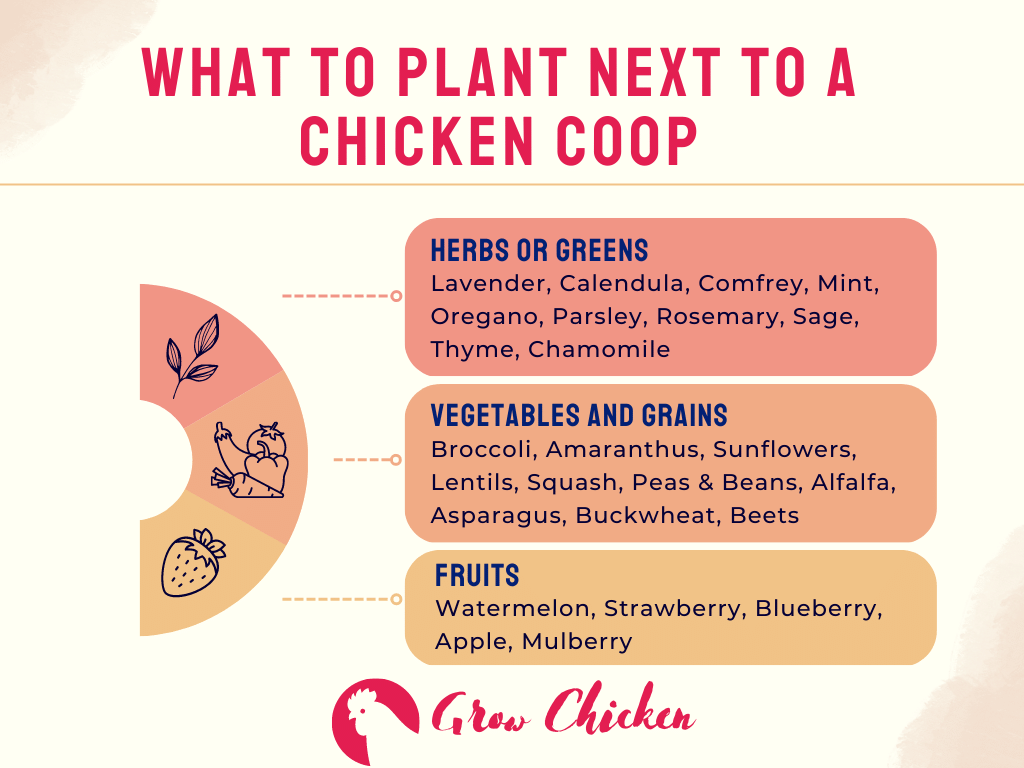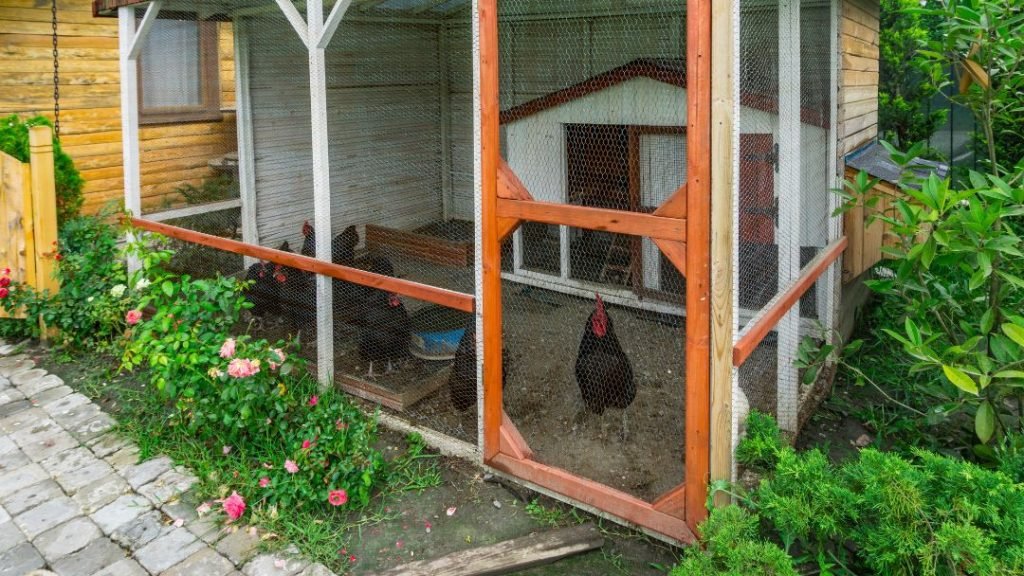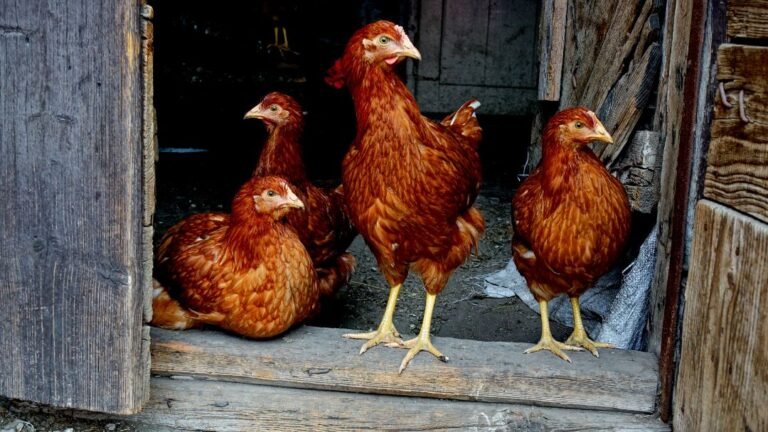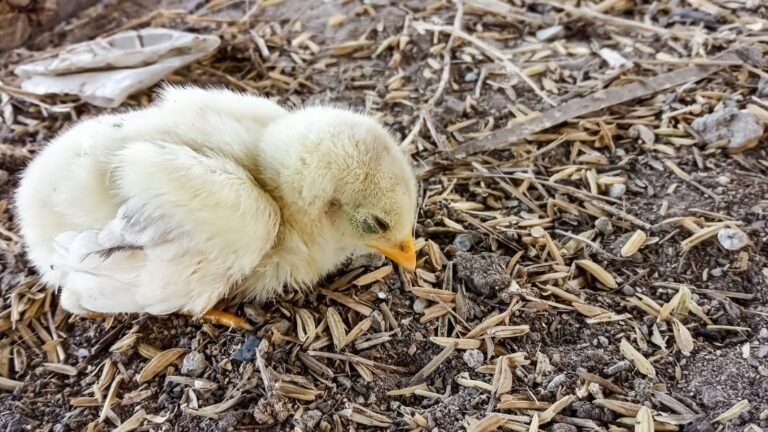Do you have a chicken coop in your backyard? How about adding a few beneficial plants? Apart from creating an appealing look, your flocks will be benefitted. Chickens will eat leaves and fruits from these plants and enjoy their own company.
What to plant next to the chicken coop? You can grow various herbs or greens, vegetables, grains, fruits, shrubs, and small trees close to the flock house. But considering the amount of space you have and maintaining enough free-range area is crucial.
What to Plant Next To Chicken Coop?
You have a lot of options to plant near your flock house. A balanced diet is a must for flocks to ensure optimal growth.
Plant various herbs, vegetables, grains, and fruits near the chicken coop to feed your birds better quality food.

Herbs Or Greens
Chickens love herbs or greens. Herbs are great for improving flocks’ immunity. They also protect birds from parasites.
Regularly eating greens makes chickens happy and healthy. It reduces their boredom too.
You can plant lavender, bee balm, calendula, mint, chamomile, comfrey, dandelion, marigold, garlic, oregano, etc.
Sage, thyme, peppermint, basil, nasturtium, chickweed, stinging nettles, etc., are also beneficial for chickens and are known as medicinal herbs.
You can plant many perennial and annual herbs next to the chicken coop. Feed your flocks one to two tablespoons of herbs every day.
You can mix them with regular chicken feeds. But, don’t let them eat too many herbs. As it could be dangerous for them.
| # | Herbs or Greens | Benefits |
| 01 | Lavender | – Improves blood circulation – Causes natural calming effects – Relieves stress |
| 02 | Calendula | – Improves yolk color naturally – Supports healthy digestion – Makes skin healthier |
| 03 | Comfrey | – Increased protein and lower fiber – Promotes fresh skin growth – Enhances egg yolk color |
| 04 | Mint | – Improves egg quality and overall health – Perfect for repelling insects and rodents – Better performance of laying hens |
| 05 | Oregano | – Creates a healthy digestion system – Better feed intake and conversion – Strengthens the immune system |
| 06 | Parsley | – Improves circulatory system development – Creates strong laying stimulant – Boosts immune system |
| 07 | Rosemary | – Relives various types of pains – Enhances respiratory health – Protects vital organs from diseases |
| 08 | Sage | – Reduces Salmonella and other contagious diseases – Works excellent against fungi and yeast – Wards off infections and deters parasites |
| 09 | Thyme | – Increases growth performance and egg production – Keeps the respiratory tract healthy – Improves the intestinal barrier integrity |
| 10 | Chamomile | – Prevents illness and bruises – Effectively fight against fight lice, mites, and fleas – Works as a natural healing agent |
Vegetables and Grains
Chickens can eat various types of vegetables, such as broccoli, beets, Amaranth, carrots, bananas, bok choy, Alfalfa, silver beet, etc.
Keeping enough amounts of vegetables and grains will ensure a nutritionally balanced diet.
These vegetables are high in protein and fiber for better egg production, boosted immunity, and other biological functions.
It also helps them to create a healthy digestive system. Feed your flocks around 100-120 grams of vegetables daily if it is fully grown.
| # | Vegetables and Grains | Benefits |
| 01 | Broccoli | – Helps to lay more eggs – Prevents bone-related issues – Improves blood clotting |
| 02 | Amaranthus | – Reduces weight gains – Proper development of the digestive tract – Improves egg production |
| 03 | Sunflowers | – Control high blood pressure and high cholesterol – Re-grow quality feathers – Healthy muscles and circulatory system |
| 04 | Lentils | – Better laying hen performance – Prevents muscle weakness – Improves growth performance |
| 05 | Squash | – Resistance against diseases and mortality – Good conditions of epithelial cells – Positive effects on bone and shell quality |
| 06 | Peas & Beans | – Promotes a healthy immune system – Boosts weight gain and health – Decreases the digestibility of nutrients |
| 07 | Alfalfa | – Stimulates scratching behavior – Highly important for ammonia emissions – Improves Redox status and breast quality |
| 08 | Asparagus | – Better bone health – Regulates blood clotting – Maintains balanced Fe levels |
| 09 | Buckwheat | – Boosts immune systems – Reduces the effects of heat stress – Enhances egg production |
| 10 | Beets | – Decreases reduce blood pressure – Better blood flow Improves gut health |
Fruits
You can plant various fruits near your chicken coop, such as watermelon, strawberries, blueberries, apples, etc.
For example, apples contain various nutrients to keep your flock healthy. Their pectin and amino acids can increase intestinal viscosity and lessen nitrogen loss.
Watermelon is an excellent fruit to keep chickens hydrated during the summer months. It prevents acute heat exhaustion too. Make sure to feed ripe watermelons.
Vitamin K, vitamin C, and fiber are the top nutrients available in blueberries. They have a decent amount of antioxidants too.
Keep 10% fruits in your chicken diet to ensure optimal health growth.
Small Plants
Planting small trees near the chicken coop serves two purposes. It offers shelter to flocks and fruits to maintain a healthy balanced diet.
Mulberry, Choko, Tree lucerne, Arrowroot, Tamarillo, etc., are top choices for chicken coops.
For example, Mulberry leaves have β-carotene. It helps improve hens’ egg yolks and their skin pigmentation.
Chickens will have a better endocrine and immunity system by eating these leaves regularly.
Lucerne tree leaves contain 14% protein and a higher amount of Vitamin A. The tree also brings moisture through the roots.
Does your living location have an extreme cold or hot conditions? Choko trees can offer ample insulation if you plant them next to the chicken coop.
Chickens love to eat their leaves and growing tips. It contains a decent amount of vitamin E, vitamin C, and folate. But, they are not fond of eating raw fruits.

What Plants Avoid Growing Next To Chicken Coops?
Avoid growing any mildly poisonous plants near your chicken house.
Regularly eating poisonous will cause weight loss issues. Flocks may suffer anemia too. They will become sick within a short period.
Some birds are seen developing tremors. At worst, chickens may even die if you don’t treat them on time.
Apricots, Daphne, Azalea, Daffodils, Bracken, Tulips, Bloodroot, Carelessweed, Ferns, Castor Bean, etc., are highly toxic plants for chickens.
For example, eating flowers and leaves of Daffodil can cause tremors and diarrhea problems. The same goes for Daphne.
Tulip is another poisonous plant that has convallarin and convallamarin. Chickens will become weaker and become lethargic if they eat tulips.
Eating Ferns bracken ferns results in muscle tremors and anemia if flocks eat them in larger quantities. After all, it contains cyanide and some lethal toxins and poisons
Final Words
Planting a few chicken-friendly trees will provide your flock shelter during the summer and rainy seasons. Your birds will also enjoy some quality fruits, vegetables, and greens.
But make sure they don’t overeat. Otherwise, it will affect their health negatively. Also, avoid planting any toxic plants that can endanger chickens’ life.
Knowing “What to plant next to the chicken coop?” is crucial if you want to create a healthy ecosystem for your flocks. Always give your best efforts to earn the best results!



